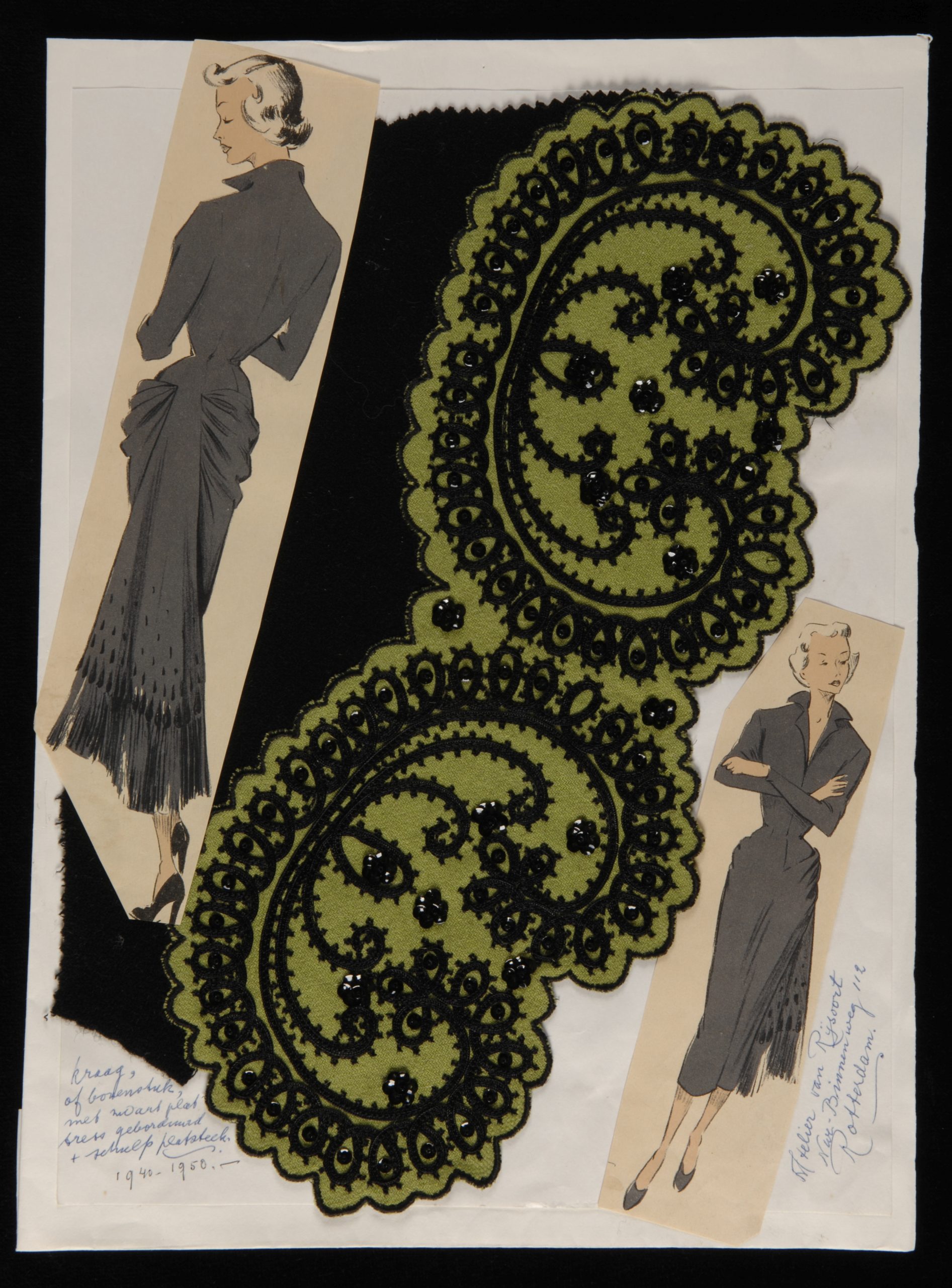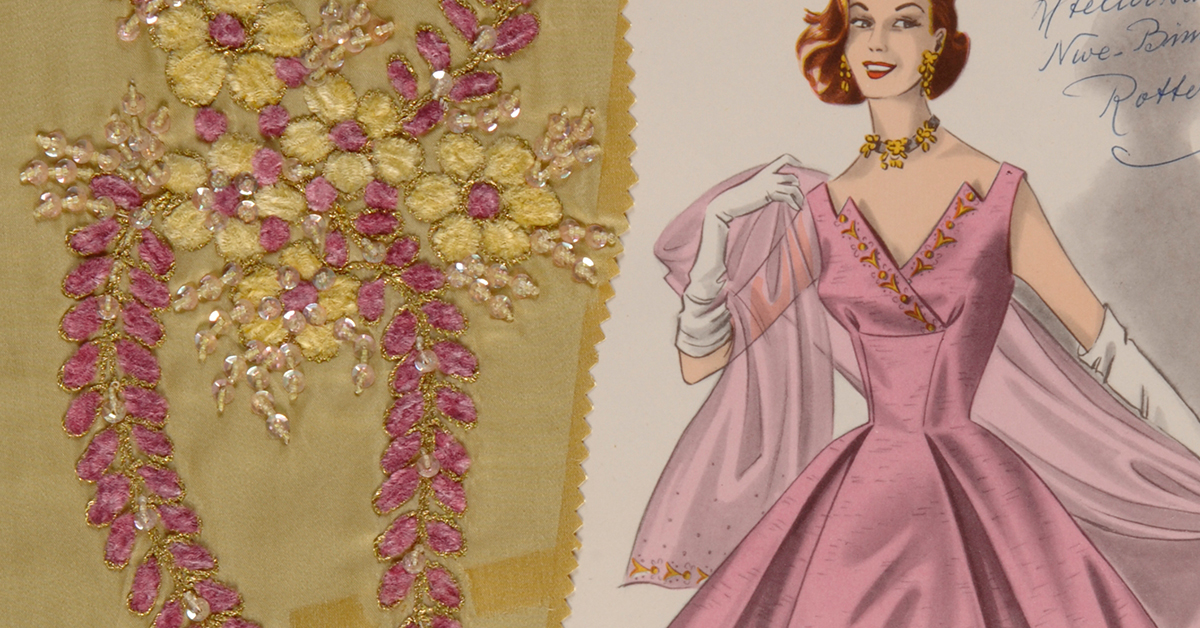
By Marta Kargól
Some years ago, I discovered an extraordinary collection of embroidery samples preserved in The Museum Rotterdam. The collection consists of more than 250 embroidery samples, patterns and fashion drawings. These objects bear witness to the great yet forgotten talent of the Dutch embroidery designer Nellie van Rijsoort, who successfully ran her own atelier in Rotterdam between 1932 and 1936. In my article Restoring the Memory of the Forgotten Dutch Embroidery Designer Nellie van Rijsoort (1910–1996) published in Costume, I wrote about the life and work of van Rijsoort. I also discussed her collection of embroidery samples and its contribution to the study of costume history.
Nellie van Rijsoort’s atelier was specialised in custom-made embroideries and served prominent middle- and upper-class clients, mostly from the Netherlands. However, van Rijsoort had international customers as well. When she opened her atelier, tailor-made clothing was still the usual practice. The embroidery atelier worked together with a network of dressmakers who encouraged their customers to have their newly-sewn outfits embellished with unique embroideries. Subsequently, van Rijsoort received orders from prominent Dutch fashion houses and textile establishments based mostly in The Hague and Amsterdam.


(Left) Atelier van Rijsoort, Embroidery samples, 1946-1956, Museum Rotterdam (20969-1-4), (Right) Atelier van Rijsoort, Embroidery samples, 1957, Museum Rotterdam (20970-1-3)
Individual customers made their choices based on embroidery samples and catalogues that now belong to the collection of The Museum Rotterdam. The final effect was never the same, as the patterns could be expanded, reduced or multiplied. The customers, assisted by the staff of the atelier, could also decide which part of the dress the embroidery would be placed on and which colours would make the outfit the most exquisite. An initial price was quoted for a single embroidery motif. Keeping in mind their budget, customers could make individual choices. Even a tiny embroidery decoration could add uniqueness and splendour to their outfits, and they were ready to pay the price for what it was worth.
In 1956, the van Rijsoort family moved to Australia, in order to make a fresh start there. They arrived in Melbourne, which was a flourishing centre of Australian fashion back then. Van Rijsoort started her own label “Fabienne” and created exclusively haute couture embroidery. For almost two decades, she successfully continued her career, working for local fashion designers and later for Australian television and theatre.
The family left the Netherlands for a couple of reasons, both personal and professional. Their atelier was experiencing growing difficulties, constantly losing customers who began opting for ready-to-wear clothing offered by an increasing number of department stores in the Netherlands. Along with a progressive disappearance of tailor-made clothing, demand for custom-made embroideries also decreased considerably. Department stores offered high-quality clothing that, although not unique, was often cheaper. Ready-to-wear fashion saved customers the time they previously had to spent on measuring sessions at tailors’ ateliers. People could also purchase a greater number of outfits, and a dress was no longer considered a product for a lifetime. Consequently, investing in expensive and time-consuming embellishments of outfits made less sense.
Moreover, the old practice of creating one’s own wardrobe no longer fitted in with the increasingly fast pace of life. From 1957 onwards, married Dutch women were allowed to work. However, van Rijsoort running her own embroidery atelier was an exception, which was possible only due to the unconditional support of her husband. The situation of married women did not change instantly once the law permitted them to work. However, social transformations had at least been initiated, and these contributed to a gradual evolution of daily life practices.


(Left) Atelier van Rijsoort, Embroidery samples, 1940-1950, Museum Rotterdam (23615-1-4), (Right) Atelier van Rijsoort, Embroidery samples, 1940-1950, Museum Rotterdam (20965)
In Australia, van Rijsoort stopped producing custom-made embroideries in favour of haute couture, to match developments within the production and consumption trends in the clothing market. In the seventies of the 20th century , haute couture also started losing its wider audience as mass-produced clothing began to increasingly take dominance. Therefore, Van Rijsoort decided to end her career and donated her embroidery samples to The Museum Rotterdam, the city of her birth, where her adventure with embroidery had begun.
Nowadays, fast fashion makes us easily forget that dressmaking was once a craft. Clothing today is ephemeral and easily replaced with new items. We are convinced that we have plenty of choices, without realising that our choices are limited to colours, cuts and fabrics which someone else has preselected for us. In the times of Nellie van Rijsoort, the acquisition of clothes was a time-consuming and creative process. People chose their fabrics, discussed a cut with a dressmaker and sometimes even visited an embroidery atelier to give their outfits a unique touch. These efforts made people appreciate their wardrobe and take good care of it, so they could enjoy them for a long time. Nellie van Rijsoort’s embroidery collection reminds us of the sustainability of fashion in the past. Today, in these times of degrowth and a growing concern for sustainability, we may draw some lessons from the wonderful, detailed artefacts in this collection.
Marta Kargól, PhD, received her MA in History (2007) and History of Art (2009) from Jagielloński University in Cracow. In 2013, she obtained her PhD in Cultural Anthropology for the dissertation ‘Tradition in fashion: Dutch regional dress in various contexts of the contemporary culture’ (written in Polish), published in 2015. Since 2016, she has been writing regularly about contemporary textile art for the Dutch periodical Textiel Plus.
Costume is the journal of The Costume Society, presenting current research into historic and contemporary dress. The journal publishes articles from a broad chronological period and with a worldwide remit, maintaining a balance between practice and theory with a focus on the social significance of dress. Subscribe to the journal, or recommend to your library.






